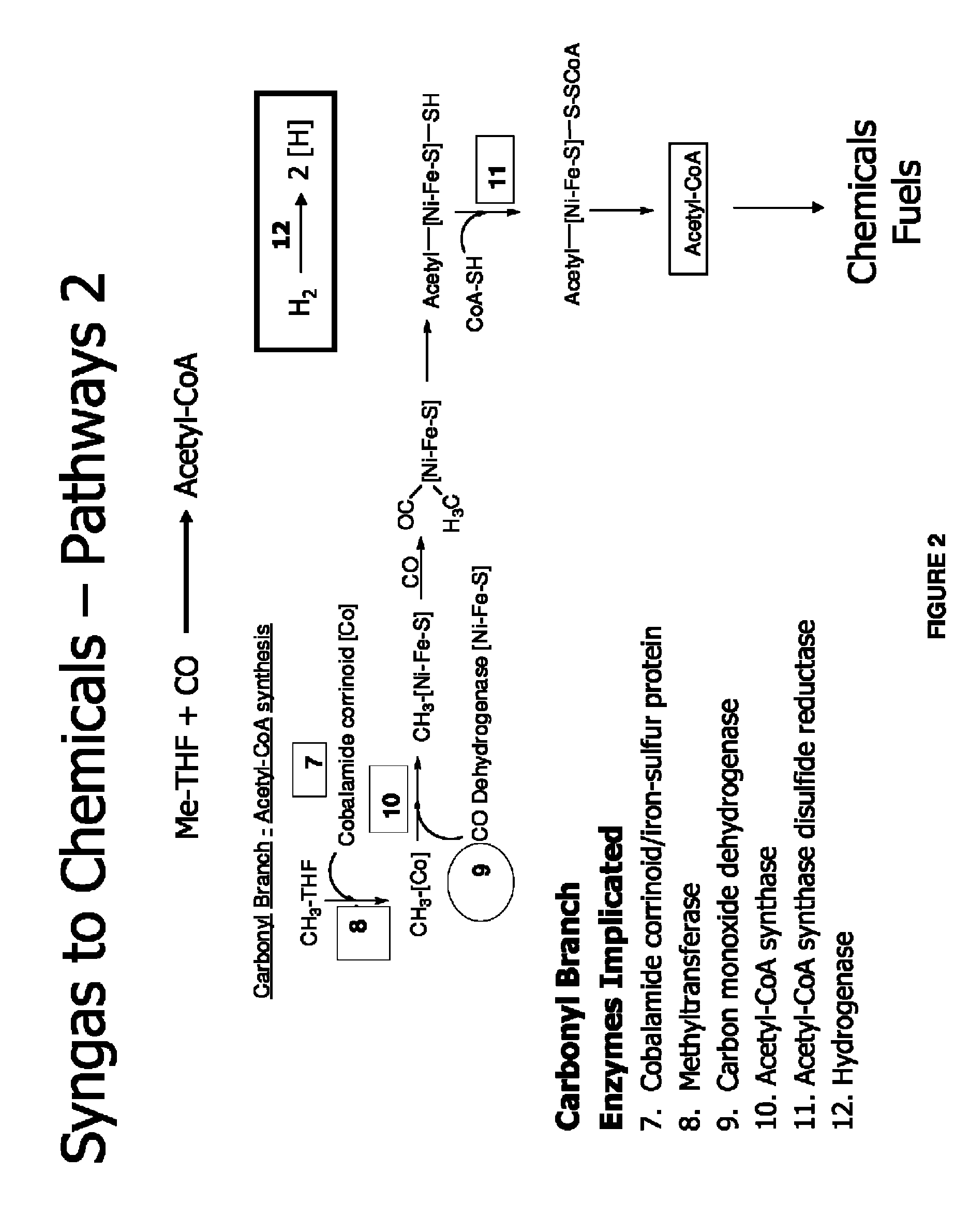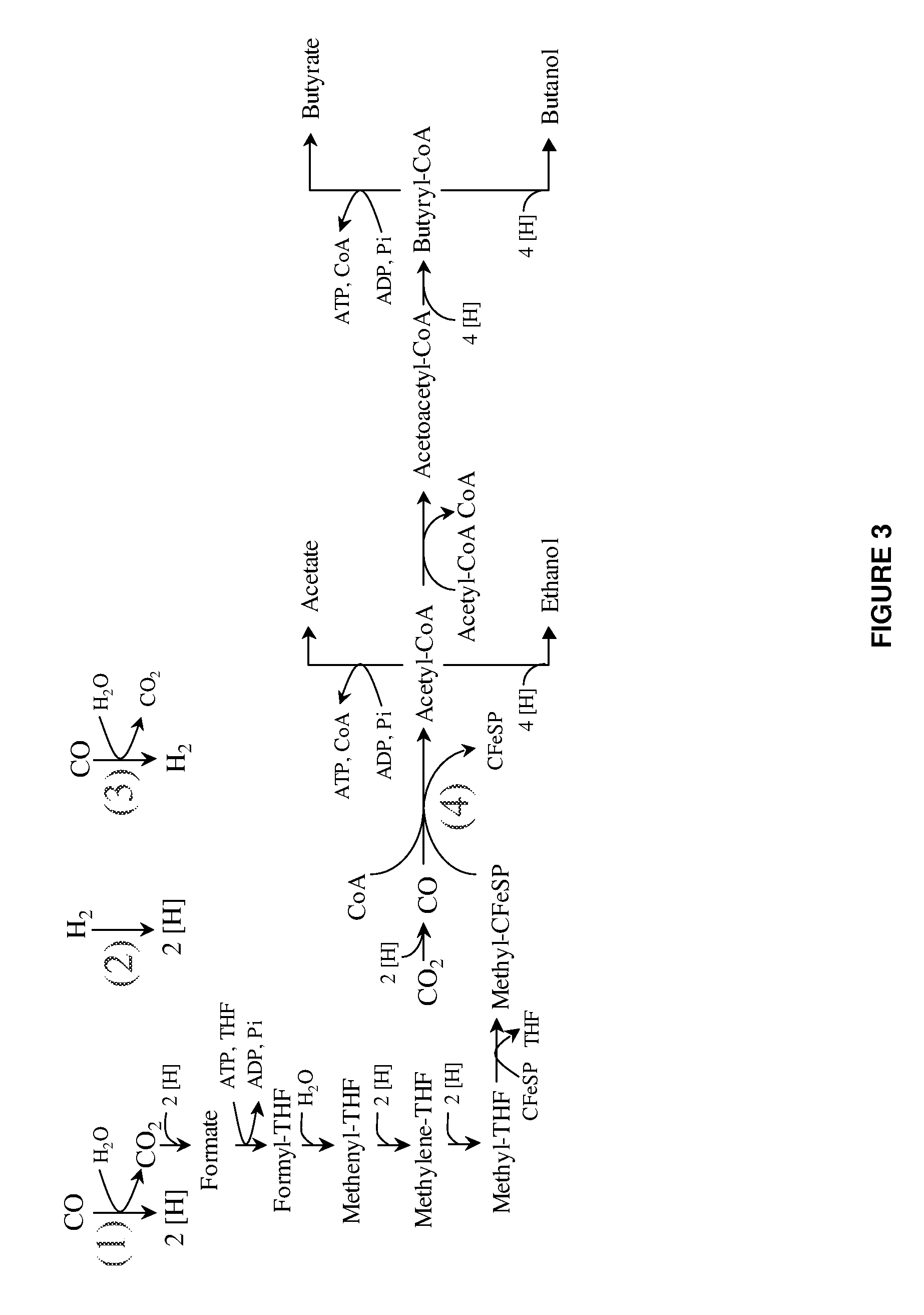Methods and organisms for utilizing synthesis gas or other gaseous carbon sources and methanol
a technology of synthesis gas and carbon source, applied in the field of biosynthetic processes, can solve the problems of limiting titers and commercialization potential, poorly characterized known organisms, and not being widely demonstrated in the field of integration with fuels or chemicals
- Summary
- Abstract
- Description
- Claims
- Application Information
AI Technical Summary
Benefits of technology
Problems solved by technology
Method used
Image
Examples
example i
Organisms and Pathways for Syngas Fermentation
[0113]This example describes organisms capable of utilizing syngas and exemplary pathways.
[0114]At least thirty different organisms have been isolated through the years and shown to grow on syngas or components of syngas such as CO, CO2, and H2 (Henstra et al., Curr. Opin. Biotechnol. 18:200-206 (2007); Sipma et al., Crit. Rev. Biotechnol. 26:41-65 (2006)). Table 1 provides examples of such organisms as well as a number of their properties such as their optimal temperature for growth, optimal pH for growth, doubling time, product profile, and physiological group.
[0115]
TABLE 1Examples of CO utilizing species and their physiological characteristics.PhysiologicalTSpeciesCharacterization(° C.)pHtd (h)ProductsMesophillic BacteriaAcetobacterium woodiiAcetogenic30 6.813AcetateButyribacteriumAcetogenic37612-20Acetate, ethanol,metholytrophicumbutyrate, butanolClostridiumAcetogenic375.8-6.0nrAcetate, ethanolClostridiumAceteogenic38 6.26.25Acetat...
example ii
Design and Modeling of Microbial Strains for Utilization of Syngas
[0124]This example describes the design of exemplary microbial strains for the production of a desired product from syngas.
[0125]Initial studies utilize genome-scale models of C. ljungdahlii, C. carboxidivorans, and R. rubrum for the design of microbial strains capable of utilizing syngas as a carbon source. Metabolic models and simulation algorithms are used to develop strains that utilize syngas. Genomic sequences of desired microorganisms are utilized, along with sequences from closely related species, to construct genome-scale metabolic models of the target organisms. To facilitate this process, Genomatica has developed a comprehensive methodology to automatically build a first draft of a metabolic network based on an exhaustive sequence comparison with our existing high quality manually built metabolic models. Next, the automatically generated gene-protein-reaction (GPR) assignments, see FIG. 2, are checked manua...
example iii
Development of Genetic Tools for Target Organisms
[0129]This example describes the development of tools for genetic manipulation and engineering of target organisms.
[0130]Genetic systems are developed in candidate strains for utilization of syngas. In particular, genetic systems are developed for C. ljungdahlii and C. carboxidivorans. Genetic transformations are also tested in Rhodospirillum rubrum. Antibiotic resistance is tested to determine potential markers for selection of desired genetic elements. For example, many Clostridia are sensitive to erythromycin and chloramphenicol. DNA transfer methods are developed using well known methods, including but not limited to electroporation, conjugation or ultrasound transformation. Additional testing is performed on several expression vectors of gram positive bacteria, particularly the vectors used in C. acetobutylicum, to determine their effectiveness for expression of desired genetic elements in C. ljungdahlii and / or C. carboxidivorans...
PUM
| Property | Measurement | Unit |
|---|---|---|
| temperatures | aaaaa | aaaaa |
| temperatures | aaaaa | aaaaa |
| concentrations | aaaaa | aaaaa |
Abstract
Description
Claims
Application Information
 Login to View More
Login to View More - R&D
- Intellectual Property
- Life Sciences
- Materials
- Tech Scout
- Unparalleled Data Quality
- Higher Quality Content
- 60% Fewer Hallucinations
Browse by: Latest US Patents, China's latest patents, Technical Efficacy Thesaurus, Application Domain, Technology Topic, Popular Technical Reports.
© 2025 PatSnap. All rights reserved.Legal|Privacy policy|Modern Slavery Act Transparency Statement|Sitemap|About US| Contact US: help@patsnap.com



